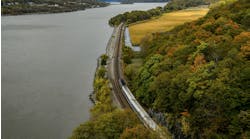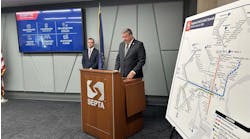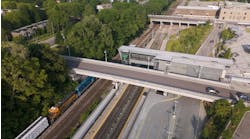Great Western Railway is providing over 4,800 extra trains seats into and out of London Paddington at the busiest times of the morning.
Watch the first Class 387 Electrostar journey under the wires from Reading to London Paddington here.
New, and more modern trains mean that the company will be able to deliver 10 percent more train seats at the busiest time of the morning into and out of London Paddington, compared to January 2017.
The new services mark a major milestone in the modernization of the Great Western Mainline, and follows Network Rail’s successful work to electrify rail lines between Paddington and Didcot — a key part of its Railway Upgrade Plan.
In London and the Thames Valley, the GWR fleet of 45 Electrostar trains have replace the majority of the 25-year-old fleet currently operating in the region, providing vital additional capacity. The trains will predominantly run in 8 and 12-carriage formations, providing up to 30 percent more seats on key journeys; and will operate under electric power between Didcot and London Paddington for the first time.
Alongside the introduction of Intercity Express Trains, the improvements will mean over 4,800 more seats into and out of London Paddington in the morning peak (between 0700 and 0959), a 10 percent increase in capacity when compared to January 2017.
Services covering Bristol, Gloucester, Cardiff and Taunton will also see more modern trains introduced, providing up to double the number seats per train. This means GWR will have introduced 3,000 more seats for commuters in the morning peak alone through Bristol Temple Meads since January 2017. As well as more seats. These trains have improved air conditioning, free WiFi and accessible toilets.
GWR Managing Director Mark Hopwood said: “Today marks a massive step towards delivering the capacity improvements we have promised, and the most significant series of improvements for rail passengers in a generation.
“Electric trains have run under the wires between Didcot and London for the first time, delivering real improvements for our passengers in London and the Thames Valley and enabling us to make further improvements throughout our network, supporting the communities we serve.
“Let me also take this opportunity to thank our passengers for their patience during the Christmas period, as Network Rail continued Crossrail works, and its program to modernize the Great Western.”
New Intercity Express Trains, GWR’s long-distance fleet, have also reached Great Malvern, Worcester and Oxford for the first time, and even more journeys will be operated by the new trains on routes between London and South Wales, Bristol, and Taunton. The trains are being built by the 900-strong workforce at Hitachi’s North East factory in Newton Aycliffe, as part of the Government’s £5.7bn Intercity Express Program.
In total 36 x 5 carriage trains and 21 x 9 carriage are being built with all trains due in service by December 2018, and a significant timetable change in January 2019 realizing the full capacity and frequency benefits the new trains will bring. Journey times from Bristol will be slashed by up to 17 minutes, and by up to 14 minutes from Swansea.
Network Rail Western Route Managing Director Mark Langman said: “This is another major step forward in the biggest ever transformation on the Great Western Mainline as we deliver more trains, more seats and better journeys for communities across the route.
“This will boost local communities and provide a better service for passengers travelling in Didcot, Reading, across the Thames Valley and west London.
“It has been a real team effort as Network Rail and GWR staff worked tirelessly to get to this stage. It is an example of track and train working together for the benefit of the passenger and really does herald an exciting time on the railway.”


